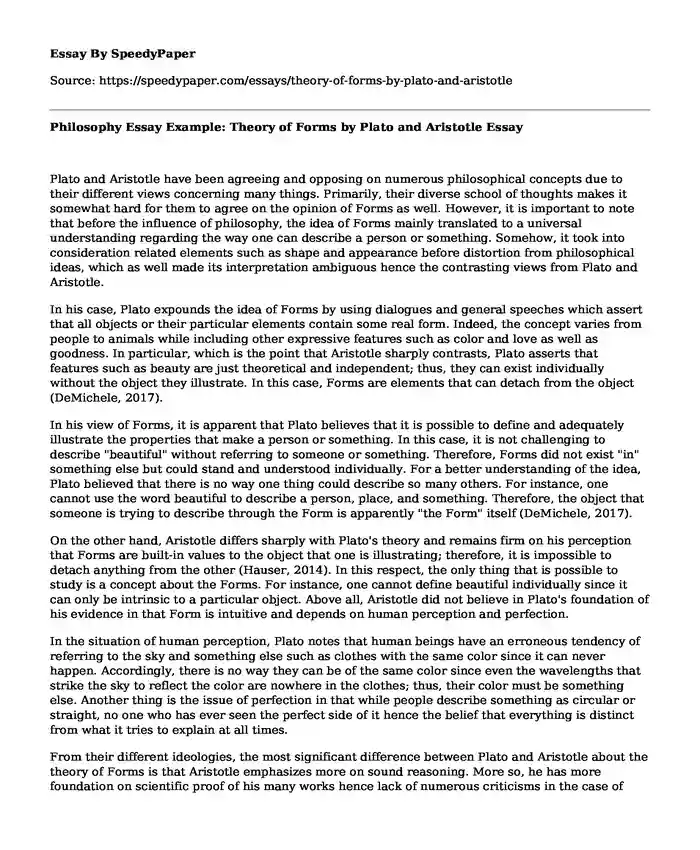
| Type of paper: | Essay |
| Categories: | Philosophy Philosophers Plato |
| Pages: | 3 |
| Wordcount: | 647 words |
Plato and Aristotle have been agreeing and opposing on numerous philosophical concepts due to their different views concerning many things. Primarily, their diverse school of thoughts makes it somewhat hard for them to agree on the opinion of Forms as well. However, it is important to note that before the influence of philosophy, the idea of Forms mainly translated to a universal understanding regarding the way one can describe a person or something. Somehow, it took into consideration related elements such as shape and appearance before distortion from philosophical ideas, which as well made its interpretation ambiguous hence the contrasting views from Plato and Aristotle.
In his case, Plato expounds the idea of Forms by using dialogues and general speeches which assert that all objects or their particular elements contain some real form. Indeed, the concept varies from people to animals while including other expressive features such as color and love as well as goodness. In particular, which is the point that Aristotle sharply contrasts, Plato asserts that features such as beauty are just theoretical and independent; thus, they can exist individually without the object they illustrate. In this case, Forms are elements that can detach from the object (DeMichele, 2017).
In his view of Forms, it is apparent that Plato believes that it is possible to define and adequately illustrate the properties that make a person or something. In this case, it is not challenging to describe "beautiful" without referring to someone or something. Therefore, Forms did not exist "in" something else but could stand and understood individually. For a better understanding of the idea, Plato believed that there is no way one thing could describe so many others. For instance, one cannot use the word beautiful to describe a person, place, and something. Therefore, the object that someone is trying to describe through the Form is apparently "the Form" itself (DeMichele, 2017).
On the other hand, Aristotle differs sharply with Plato's theory and remains firm on his perception that Forms are built-in values to the object that one is illustrating; therefore, it is impossible to detach anything from the other (Hauser, 2014). In this respect, the only thing that is possible to study is a concept about the Forms. For instance, one cannot define beautiful individually since it can only be intrinsic to a particular object. Above all, Aristotle did not believe in Plato's foundation of his evidence in that Form is intuitive and depends on human perception and perfection.
In the situation of human perception, Plato notes that human beings have an erroneous tendency of referring to the sky and something else such as clothes with the same color since it can never happen. Accordingly, there is no way they can be of the same color since even the wavelengths that strike the sky to reflect the color are nowhere in the clothes; thus, their color must be something else. Another thing is the issue of perfection in that while people describe something as circular or straight, no one who has ever seen the perfect side of it hence the belief that everything is distinct from what it tries to explain at all times.
From their different ideologies, the most significant difference between Plato and Aristotle about the theory of Forms is that Aristotle emphasizes more on sound reasoning. More so, he has more foundation on scientific proof of his many works hence lack of numerous criticisms in the case of Plato. However, the two philosophers concur on the idea that Forms exist and illustrate concepts and personalities. However, even if they are demonstrative aspects, Aristotle argues that it is impractical to detach them since they cannot exist undetached from the objects they describe.
References
DeMichele, T. (2017). Plato's Allegory of the Cave and Theory of the Forms Explained. N.p.: Fact/Myth.
Hauser, E. (2014). Aristotle and Plato on the Subject of Forms. N.p.:Sensible Reason.
Cite this page
Philosophy Essay Example: Theory of Forms by Plato and Aristotle. (2022, Mar 18). Retrieved from https://speedypaper.com/essays/theory-of-forms-by-plato-and-aristotle
Request Removal
If you are the original author of this essay and no longer wish to have it published on the SpeedyPaper website, please click below to request its removal:
- Dark Matter Essay Exam[ple
- When Did the US Enter WW2 - Free Essay in History
- Free Essay about Ebola Virus in Sierra Leone
- Free Essay: Evaluation of Nurses' Handover Practice in an Acute Outpatient Dialysis Unit
- Free Essay Example on the Problem of Evil and Suffering
- Technology, Work, and Organizations. Paper Exampl
- Rock Solid Industry Parts, IncExecutive Summary
Popular categories




